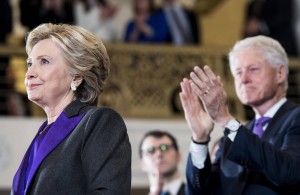How Hillary Lost the White House
< < Go Back
When staffers questioned campaign manager Robby Mook, the same response always came back: ‘The data run counter to your anecdotes.’ Barton Swaim reviews ‘Shattered’ by Jonathan Allen and Amie Parnes.
‘This is too easy,” Barack Obama is recorded as saying in “Shattered,” an exhaustive account of Hillary Clinton’s ill-fated 2016 presidential campaign. The president had just delivered a well-received speech in praise of Mrs. Clinton’s candidacy; both Mr. Obama and Mrs. Clinton had derided Donald Trump, the Republican nominee, as a malignant nincompoop. John Podesta, the Clinton campaign’s chairman, looked at the president doubtfully. Too easy? “All right, all right, all right,” Mr. Obama playfully conceded. “There’s just so much material.”
The remark nicely captures the attitude not just of the Clinton campaign but of almost the entire Democratic establishment in the months before the election. “Shattered,” by campaign reporters Jonathan Allen and Amie Parnes, narrates the petty bickering, foolish reasoning and sheer arrogance of a campaign that was never the sure thing that its leader and top staffers assumed. The authors, in a mostly successful attempt to get their sources to talk candidly, promised them that they wouldn’t be identified.
The juicy quotes would mean more if they were on the record, but mostly it works: You can’t pinpoint the identity of any one “top aide” or “close Hillary ally,” but the authors’ language leads you to believe they include the most senior Clinton advisers—Mr. Podesta, longtime Clinton confidante Huma Abedin, campaign manager Robby Mook, speechwriter Dan Schwerin, policy adviser Jake Sullivan —and probably the candidate herself.
For those few unhappy addicts who wish to relive the 2016 presidential campaign so soon, “Shattered” offers a number of gratifying revelations. Among them: Mrs. Clinton’s tinkering with a certain computer server. Not that server—a different one. After losing to Mr. Obama in the protracted 2008 primary, she was convinced that she had lost because some staffers—she wasn’t sure who—had been disloyal. So she “instructed a trusted aide to access the campaign’s server and download the [email] messages sent and received by top staffers.” This tells us, first, that Mrs. Clinton possesses an almost Nixonian paranoia about treachery and, second, that her use of a private email server at the State Department was never the naive “mistake” she pretended it was. In fact, she didn’t want anyone reading her emails the way she was reading those of her 2008 staffers.
Mr. Allen and Ms. Parnes stress two essential failures of the campaign, the first structural, the second political. The campaign’s command structure, the authors write, was an “unholy mess, fraught with tangled lines of authority, petty jealousies, distorted priorities, and no sense of greater purpose.” Mrs. Clinton herself was inaccessible to almost everyone but Ms. Abedin, whose role was never clarified, so top staffers broke off into mutually mistrustful tribes: the campaign data analysts, Mrs. Clinton’s State Department coterie, Clinton Foundation staff, and the enthusiasts associated with the Ready for Hillary super-PAC.
This diffuse command structure was a consequence, the authors suggest, of the fact that Mrs. Clinton didn’t know why she wanted to be president. At one point no fewer than 10 senior aides were working on her campaign announcement speech; not one had a clear understanding of why Americans should cast their votes for Mrs. Clinton and not someone else.
The Clinton campaign’s other failure was rooted in a mistaken assumption about the nature of politics. The campaign relied too much on analyzing data and too little on getting the candidate in touch with actual people. Mrs. Clinton’s young staffers came of age during Barack Obama’s campaigns and thought they’d mastered the art of electoral politics. They failed to realize that Mr. Obama won for a variety of sociological and political reasons that had nothing to do with his campaign’s analysis of data. Successful politicians must have a tacit sense of what voters want to hear and how they might be persuaded. Mrs. Clinton—in stark contrast to her husband—was never interested in that component of campaigning. You got the feeling she didn’t like people all that much.
Mr. Mook’s scientific “model” of how the campaign should run emphasized demographics, constituents’ voting histories, regional electoral patterns, and so on. When staffers objected to his directives, the authors record, the response was always the same: “The data,” as Mr. Mook at one point put it to former President Bill Clinton, “run counter to your anecdotes.”
So, for instance, when campaign staffers discussed ideal locations for Mrs. Clinton’s first appearance with President Obama, several aides suggested Green Bay, Wis. Mr. Mook objected on the specious grounds that “voters there wanted change and Obama’s presence would suggest to voters that Hillary was running for his third term.” Of course, if the campaign had scheduled the event for Green Bay, Mrs. Clinton might have visited Wisconsin at least once. But she never went there, and Donald Trump won the state by less than 1%.
Such insights aside, “Shattered” is not a pleasure to read.
More From The Wall Street Journal (subscription required):




